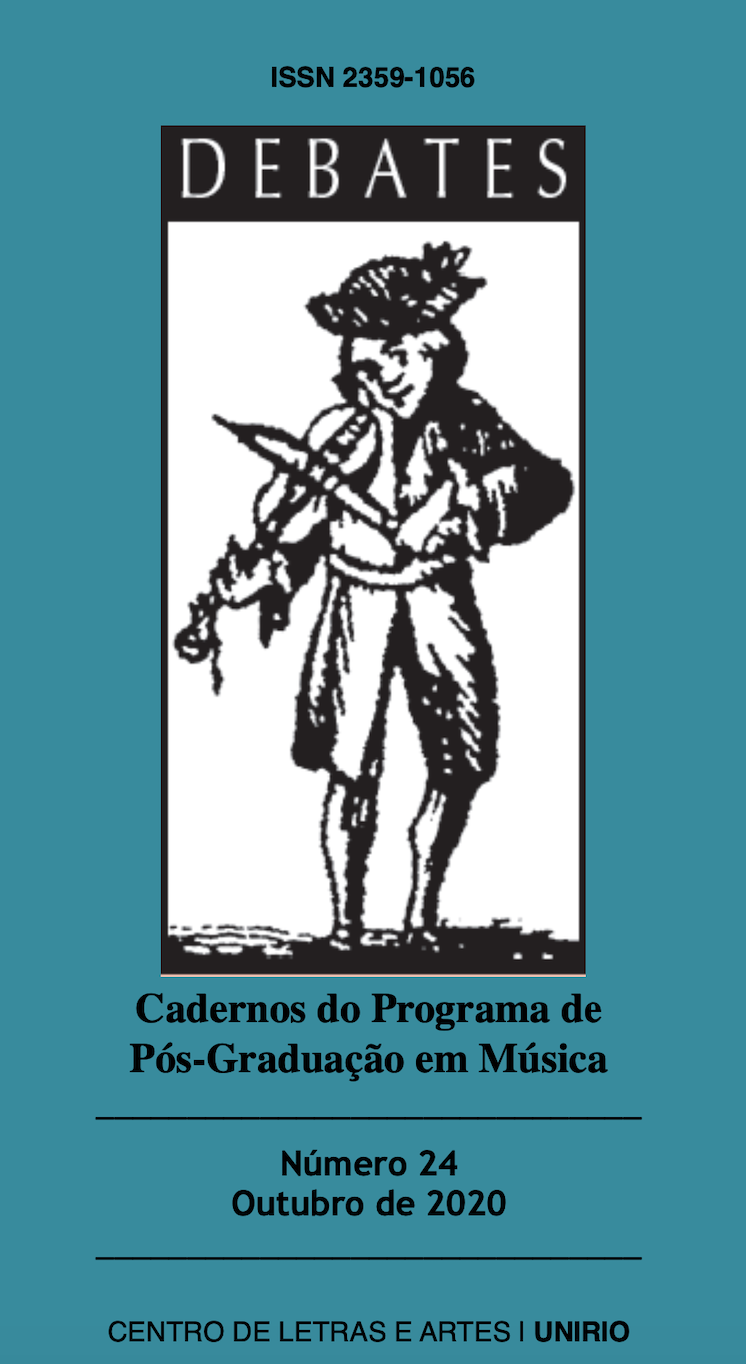Estratégias de expansão da Teoria Schenkeriana a partir da música de Igor Stravinsky
Keywords:
Análise Schenkeriana, Neo-Schenkerianismo, Epistemologia, Filosofia da música.Abstract
Este artigo apresenta um recorte do neo-schenkerianismo, delineando uma trajetória da dissolução e inversão dos fundamentos da teoria original. Foca-se nos problemas metodológicos ocasionados a partir das aplicações da Análise Schenkeriana na música de Igor Stravinsky. São nomeadas quatro estratégias e organizadas da mais próxima à mais distante da teoria original. São elas: (1) a reconfiguração da superfície; (2) a dedução de estruturas profundas; (3) a reconsideração da unidade mínima de referência; (4) e a atualização de hierarquias. Estas estratégias são discutidas emseus aspectos metodológicos, estéticos e éticos. Esse levantamento fomenta um amplo debate epistemológico sobre os limites e alcances da análise musical; e sobre a relação entre os sujeitos que analisam, seus modos de investigação e os objetos de estudo da musicologia sistemática.
Downloads
References
AGAWU, Kofi. Schenkerian Notation in Theory and Practice. In.: Music Analysis Vol. 8, No. 3, pp. 275-301, 1989.
BERRY, David Carson. “Schenker’s First ‘Americanization’:George Wedge, the Institute of Musical Art, and the ‘Appreciation Racket’”. In: A Music- Theoretical Matrix: Essays in Honor of Allen Forte (Part III), ed. David Carson Berry, Gamut 4/1, p. 143–230. 2011
COHN, Richard. Schenker’s Theory, Schenkerian Theory: Pure Unity or Constructive Conflict? In.: Indiana Theory Review, n .13, v. 1, p.1-19, 1992.
_____________; DEMPSTER, Douglas. Hierarchical Unity, Plural Unities. In.: Disciplining Music. p. 156-181. Chicago: Chicago University Press, 1992.
DELEUZE, Guilles; GUATTARI, Félix. Mil platôs: Capitalismo e esquizofrenia. São Paulo: Editora 34, 2000 [1980].
FINK, Robert. Going flat: Post-Hierarchical Music Theory and the Musical Surface. In.: Rethinking Music. Oxford: Oxford University Press, 2001.
FORTE, Allen. New Approaches to the linear music. In.: Journal of the American Musicological Society. Vol. 41, No. 2, pp. 315-348, 1988.
FORTE, Allen; GILBERT, Steven. Introduction to Schenkerian Analysis. New York: W. W. Norton and Company, 1982.
FORTES, Rafael. Modelagem e particionamento de Unidades Musicais Sistêmicas. Dissertação (Mestrado em Música). Programa de Pós-Graduação em Música, Centro de Letras e Artes, Universidade Federal do Rio de Janeiro, 2016.
_____________. A Estrutura Orgânica da Música na Teoria Schenkeriana. Tese (Doutorado em Música). Programa de Pós-Graduação em Música, Centro de Letras e Artes, Universidade Federal Estado do Rio de Janeiro, 2020.
HAIMO, Ethan. Atonality, analysis and the intentional fallacy. In: Music Theory Spectrum, v. 18, n. 2, p. 167-199, 1996.
LERDHAL, Fred; JACKENDOFF, Ray. A generative theory of tonal music. Massachusetts: MIT Press, 1983.
MEYER, Leonard. Grammatical simplicity and relational richness: the trio of Mozart’s G minor concerto. In.: Critical Inquiry, Vol. 2, N. 4, p. 693-761. 1976
RAPHLING, Sam. The Rite of Spring: complete ballet for piano solo. Florida: Lyra Music Company, 1979
SALZER, Felix. Structural Hearing: Tonal Coherence in Music. New york: Dover, 1982 [1952].
SCHENKER, Heinrich. The spirit of musical technique [Der Geist der Musikalischen Technik, 1895]. Traduzido por William Pastille. In.: COOK, Nicolas. The Schenker project: Culture, Race, and Music Theory in Fin- de-siècle Vienna. Oxford: Oxford university press, 2007. p. 319-332. [1895]
_____________. Counterpoint: a Translation of Kontrapunkt. Volume 1 New York: Schimmer books, 1987 [1910].
_____________. Der Tonwille: pamphlets in witness of the immutable laws of music. Volume 1: issues 1-5. Oxford: Oxford University Press, 2004 [1921-1923].
_____________. Der Tonwille: pamphlets in witness of the immutable laws of music. Volume 2: issues 6-10. Oxford: Oxford University Press, 2005 [1923-1924].
_____________. The Masterwork in Music. Vol. 1. Ed. William Drabkin. New York: Dover Publications, 2014a [1925].
_____________. Vol. 2. Ed. William Drabkin. New York: Dover Publications, 2014b [1926]. _____________. Vol. 3. Ed. William Drabkin. New York: Dover Publications, 2014c [1930].
_____________. Free composition. New York: Schimmer Books, 1979 [1935]. SIMON, Herbert. The architecture of complexity. In: Proceedings of the American
Philosophical Society, v. 106, n. 6, p. 467-482, 1962.
SMITH, Charles. Form and fundamental structure: An Investigation of Schenker’s
‘Formenlehre’. Music Analysis. V. 15, n 2/3, p. 191 - 297, 1996.
STRAUS, Joseph. The problem of prolongation in post-tonal music. In.: Journal of
Music Theory. V. 31, No. 1, p. 1-21, 1987.
STRAVINSKY, Igor. Poética musical em seis lições. Rio de Janeiro: Editora Zahar,
[1942].
_____________. Symphony en Three Movements. Mainz: Schott, 1984 [1942-1945]. TRAVIS, Roy. Toward a new concept of tonality? In.: Journal of Music Theory, vol. 3,
n. 2. p.257-284, 1959.


